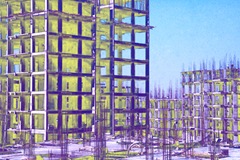Good friend and journalist Rahul Bhatia writes about the Bandra-Worli Sea Link in a recent weekly edition of the OPEN Magazine.
On the sea link that will soon connect Bandra to Worli, fifteen men swept, tarred, and patted a stretch no longer than five meters with uncommon urgency. Noxious tar, fresh off a machine that rolled forward, steamed beneath their feet. A vast expanse of concrete ready to be layered with tar loomed ahead, stretching out to a distant point. Spurred by a deadline already gone by, they pressed on without a break from their grueling work. Like them, other teams were at work in a hurry on the bridge. Above everyone, and everything, including the giant launch trusses that lift segments of the bridge into place for alignment, rose the main towers of the sea link, each made of four thick concrete legs that converged at a point 125 meters above the roadway. And behind them, higher than the towers, stood a crane. Ten years after it was commissioned, the bridge was yet to be finished.
Continue reading at Green Channel: Rahul’s blog
